Abstract
Biological monitoring is a routine method that has been applied in occupational medical practice for many years. A requirement for its application is the availability of criteria suitable for evaluating biomonitoring data. Health-based threshold values are particularly useful as a criterion, yet only for substances for which effect thresholds can reliably be determined. For substances for which the concept of health-based threshold values is not applicable, the Working Group Setting of Threshold Limit Values in Biological Materials of the DFG Commission for the Investigation of Health Hazards of Chemical Compounds in the Work Area has recently established “Biologische Arbeitsstoff-Referenzwerte” (BARs, Biological Reference Values for Chemical Compounds in the Work Area) as an approach for evaluating biomonitoring data. The BAR represents the upper reference concentration of a biomarker in the general adult population without occupational exposure to the agent. It is derived from biomonitoring data of a sample of a defined population group. In general, a BAR corresponds to the 95th percentile of the sample distribution. Ideally, national environmental surveys including human biomonitoring results are used as basis for deriving BARs. The influence of age, sex, social status, residential area and life style factors on background exposure is considered in the evaluation of these values. Because tobacco smoking is the most frequent influencing factor, several BARs have been determined for non-smokers only. To date, BARs for 17 substances or substance groups are listed in the List of MAK and BAT Values 2011. BARs for another five substances have been discussed, but have not been established because of the insufficient scientific database. Establishing the BARs aims to facilitate the evaluation of human exposure to chemical compounds for which no health-based threshold values can be derived but an adequate assessment of exposure is required due to their toxicity. The application of BARs does not permit a toxicological evaluation, but does allow the occurrence and the extent of occupational exposure to hazardous substances to be proved.
Similar content being viewed by others
References
ACGIH (American Conference of Governmental Industrial Hygienists) (2011) TLVs® and BEIs®. Based on the Documentation of the Threshold Limit Values for Chemical Substances and Physical Agents & Biological Exposure Indices. ACGIH, Cincinnati
AGS (“Ausschuss für Gefahrstoffe”, Committee for Hazardous Substances) (2008) Announcement on hazardous substances—announcement 910—risk figures and exposure-risk relationships in activities involving carcinogenic hazardous substances. Web site of the Federal Agency of Occupational Safety and Health (http://www.baua.de/cln_137/en/Topics-from-A-to-Z/Hazardous-Substances/TRGS/Announcement-910.html)
Aitio A (2006) Guidance values for the biomonitoring of occupational exposure. State of the art. Med Lav 97:324–331
Apostoli P (1999) Application of reference values in occupational health. Int Arch Occup Environ Health 72:191–194
Becker K, Kaus S, Krause C, Lepom P, Schulz C, Seiwert M, Seifert B (2002) German environmental survey 1998 (GerES III): environmental pollutants in blood of the German population. Int J Hyg Environ Health 205:297–308
Bolt HM, Thier R (2006) Biological monitoring and biological limit values (BLV): the strategy of the European Union. Toxicol Lett 162:119–124
CDC (Centre for Disease Control and Prevention) (2009) Fourth National Report on Human Exposure to Environmental Chemicals. CDC, Division of Laboratory Sciences, Atlanta (http://www.cdc.gov/exposurereport/pdf/FourthReport.pdf)
Cocker J, Jones K, Morton J, Mason HJ (2007) Biomonitoring at the UK health and safety laboratory. Int J Hyg Environ Health 210:383–386
DFG (1985–2004) Analyses of hazardous substances in biological materials, vol 1–9. Wiley, Weinheim
DFG (1994–1998) Biological exposure values for occupational toxicants and carcinogens, vol 1–3. Wiley, Weinheim
DFG (2005–2010a) The MAK-collection for occupational health and safety. Part IV: biomonitoring methods, vol 10–12. Wiley, Weinheim
DFG (2005–2010b) The MAK-collection for occupational health and safety. Part II: BAT value documentations, vol 4–5. Wiley, Weinheim
DFG (2008) List of MAK and BAT values 2008. Commission for the Investigation of health hazards of chemical compounds in the work area, Report No. 44. Wiley, Weinheim
DFG (2011) List of MAK and BAT values 2011. Commission for the investigation of health hazards of chemical compounds in the work area, Report No. 47. Wiley, Weinheim
Drexler H (2007) Aufstellung von Grenzwerten im biologischen Material. In: DFG (ed) Erfolgreiche Konzepte der Gefahrstoffbewertung—50 Jahre MAK-Kommission. Wiley, Weinheim
Drexler H, Göen T, Schaller KH (2008) Biological tolerance values: change in a paradigm concept from assessment of a single value to use of an average. Int Arch Occup Environ Health 82:139–142
Ewers U, Krause C, Schulz C, Wilhelm M (1999) Reference values and human biological monitoring values for environmental toxins. Report on the work and recommendations of the commission on human biological monitoring of the german federal environmental agency. Int Arch Occup Environ Health 72:255–260
Fiserova-Bergerova V, Ogata M (eds) (1990) Biological monitoring of exposure to industrial chemicals. In: Proceedings of the United States-Japan cooperative seminar on biological monitoring, American Conference of Governmental Industrial Hygienists, Japan Society for the Promotion of Sciences, US National Science Foundation
DFG (Deutsche Forschungsgemeinschaft) (2004) List of MAK and BAT values 2004. Commission for the investigation of health hazards of chemical compounds in the work area, Report No. 40. Wiley, Weinheim
Göen T, Eckert E, Schäferhenrich A, Hartwig A (2011) Allocation of reliable analytical procedures for human biomonitoring by the DFG Commission for the Investigation of Health Hazards of Chemical Compounds in the Work Area. Int J Hyg Environ Health (in press). doi:10.1016/j.ijheh.2011.08.013
Hallier E, Angerer J, Drexler H, Filser JG, Lewalter J, Stork J (2001) Biologische Leitwerte (BLW). Arbeitsmed Sozialmed Umweltmed 36:6–9
Hartwig A (2008) Preface. In: DFG (ed) The MAK-collection for occupational health and safety. Part IV. Biomonitoring Methods, vol 11. Wiley, Weinheim
Jang JY, Kang SK, Chung HK (1993) Biological exposure indices of organic solvents for Korean workers. Int Arch Occup Environ Health 65:S219–S222
JSOH (Japan Society for Occupational Health) (2010) Recommendation of occupational exposure limits 2010–2011. J Occup Health 52:308–324
Kemper FH, Eckard R, Günsel A, Ladas A, Oganowski M (2004) Betrieb einer Umweltprobenbank für Humanproben und Datenbank Münster. Jahresbericht 2003, Umweltbundesamt, Berlin
Kiilunen M (1999) Biomonitoring action levels in Finland. Int Arch Occup Environ Health 72:261–267
Lehnert G (1980) Biologische Arbeitsstoff-Toleranz-Werte: Ein Konzept zur Individualprävention bei Exposition gegenüber gesundheitsschädlichen Arbeitsstoffen. Arbeitsmed Sozialmed Präventivmed 15:266–270
Lehnert G, Schaller KH (1995) Strategy of biological monitoring and setting of biological threshold limits (BAT values) in Germany. Isr J Med Sci 31:549–557
Lewalter J, Neumann HG (1996a) Biologische Arbeitsstoff-Toleranzwerte (Biomonitoring). Teil VII: Hintergrundbelastungen bei beruflich nicht-exponierten Personen. Arbeitsmed Sozialmed Umweltmed 31:275–280
Lewalter J, Neumann HG (1996b) Biologische Arbeitsstoff-Toleranzwerte (Biomonitoring). Teil VIII: Bewertung der Hintergrundbelastungen bei beruflich nicht-exponierten Personen. Arbeitsmed Sozialmed Umweltmed 31:418–432
Lippman SM, Klein EA, Goodman PJ, Lucia MS, Thompson IM, Ford LG, Parnes HL, Minasian LM, Gaziano JM, Hartline JA, Parsons JK, Bearden JD III, Crawford ED, Goodman GE, Claudio J, Winquist E, Cook ED, Karp DD, Walther P, Lieber MM, Kristal AR, Darke AK, Arnold KB, Ganz PA, Santella RM, Albanes D, Taylor PR, Probstfield JL, Jagpal TJ, Crowley JJ, Meyskens FL, Baker LH, Coltman CA Jr (2009) Effect of selenium and vitamin E on risk of prostate cancer and other cancers. JAMA 301:39–51
Moreno-Reyes R, Suetens C, Mathieu F, Begaux F, Zhu D, Rivera M, Boelaert M, Neve J, Perlmutter N, Vanderpas J (1998) Kashin-Beck osteoarthropathy in rural Tibet in relation to selenium and iodine status. New Engl J Med 339:1112–1120
Morgan MS (1998) International comparison of reference values for biological monitoring. Occup Hyg 4:195–213
Morgan MS, Schaller KH (1999) An analysis of criteria for biological limit values developed in Germany and in the United States. Int Arch Occup Environ Health 72:195–204
Omae K, Takebayashi T, Sakurai H (1999) Occupational exposure limits based on biological monitoring: the Japan society for occupational health. Int Arch Occup Environ Health 72:271–273
Poulsen OM, Holst E, Christensen JM (1997) Calculation and application of coverage intervals for biological reference values. Pure Appl Chem 69:1601–1611
Salonen JT, Alfthan G, Huttunen JK, Puska P (1984) Association between serum selenium and the risk of cancer. Am J Epidemiol 120:342–349
Schaller B, Göen T, Bräu-Dümler C et al (2008) Belastung und Beanspruchung von Beschäftigten der Selen-verarbeitenden Industrie. Verh DGAUM 48:502–506
Schmid K, Lederer P, Göen T, Schaller KH, Strebl H, Weber A, Angerer J, Lehnert G (1997) Internal exposure to hazardous substances of persons from various continents: investigations on exposure to different organochlorine compounds. Int Arch Occup Environ Health 69:399–406
Schulz C, Conrad A, Becker K, Kollossa-Gehring M, Seiwert M, Seifert B (2007) Twenty years of the German Environmental Survey (GerES): human biomonitoring—temporal and spatial (West Germany/East Germany) differences in population exposure. Int J Hyg Environ Health 210:271–297
Schulz C, Wilhelm M, Heudorf U, Kolossa-Gehring M (2011) Update of the reference and HBM values derived by the German Human Biomonitoring Commission. Int J Hyg Environ Health (in press). doi:10.1016/j.ijheh.2011.06.007
SCOEL (Scientific Committee on Occupational Exposure Limits) (2009) Methodology for the derivation of occupational exposure limits: key documentation (version 6), European Commissioner for Employment, Social Affairs and Inclusion, Brussels
Son JY, Lee J, Paek D, Lee JT (2009) Blood levels of lead, cadmium, and mercury in the Korean population: results from the second Korean national human exposure and bio-monitoring examination. Environ Res 109:738–744
Triebig G, Ihring A, Bader M (2005) Manganese and its inorganic compounds. In: The MAK-collection for occupational health and safety. Part II: BAT value documentations, vol 4. Wiley, Weinheim, pp 89–115
Wiesmüller GA, Eckard R, Dobler L, Günsel A, Organowski M, Schröter-Kermani C, Schlüter C, Gies A, Kemper FH (2007) The environmental specimen bank for human tissues as part of the German environmental specimen bank. Int J Hyg Environ Health 210:299–305
Zober A, Will W (1996) Biological monitoring and risk assessment in occupational settings. Int Arch Occup Environ Health 68:389–393
Acknowledgments
The Working Group Setting of Threshold Limit Values in Biological Materials is supported by the “Deutsche Forschungsgemeinschaft”. The DFG Commission for the Investigation of Health Hazards of Chemical Compounds in the Work Area is indebted to all members and external experts of the Working Group for their contribution to the tasks of the Commission. The contribution is based on the consensus of the Working Group. The authors would like to thank the Working Group for their cooperation and support.
Conflict of interest
The authors declare that they have no conflict of interest.
Author information
Authors and Affiliations
Corresponding author
Rights and permissions
About this article
Cite this article
Göen, T., Schaller, KH. & Drexler, H. Biological reference values for chemical compounds in the work area (BARs): an approach for evaluating biomonitoring data. Int Arch Occup Environ Health 85, 571–578 (2012). https://doi.org/10.1007/s00420-011-0699-3
Received:
Accepted:
Published:
Issue Date:
DOI: https://doi.org/10.1007/s00420-011-0699-3




